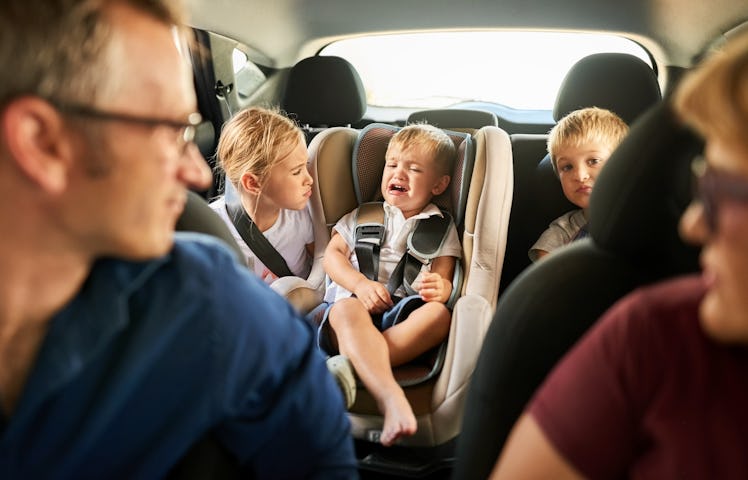5 Tricks To Get An Uncooperative Toddler Into Their Car Seat
Toddlers can be stubborn, but there are ways to work with them instead of against them.

You pride yourself on being a car seat pro. You’re going to keep your kid in a rear-facing car seat for as long as possible because you know it’s the safest thing to do. You’ve researched the best car seats, and you’ve read the manual. You even swallowed your pride and let your partner have one of the hunks down at the fire station install it properly. Now, if you could only get your freakin’ toddler to sit in the damn thing.
No matter your prowess with car-seat mechanics, there will come a point when your kid just doesn’t want to be restrained. That’s when you need to show your own restraint and apply some of these kid-strapping tips.
How to Get a Toddler in a Car Seat
It’s not just the car seat. Your toddler is probably getting defiant about many things. That’s because they’ve started understanding that they have something called “wants.” And very often, their wants are not aligned with yours.
So the game is to find out if they can make you come around to their way of doing things. Of course, having a limited ability for rhetoric and argument, their methods are largely loud and physical. The car seat is just one battleground. Here are five ways you can fight.
Give Them “Options”
One of the best ways to befuddle a toddler is to give them options. This makes them feel like they do have some agency in this world after all. Of course, the options you are giving them lead to the same goal: getting them the hell into their car seat. But they don’t know that.
So when approaching the vehicle the trick is to ask something along the lines of: “Do you want me to lift you into the car seat? Or do you want to climb in by yourself like a big kid?”
Let Them Help
This is an extension of the “options” protocol. It involves letting your kid help with the buckling. Again, the key is to bank on the desire to be a big, responsible kid. It also requires a certain amount of patience. After all, car seat buckles aren’t the easiest things to fasten in the world. And if your kid fastens the straps, make sure you check their work. It’s not like you can blame them if they pop out when you hit the brakes.
Give Them A Reason
Car seats will begin to seem way less of a hassle to your kid if there’s something to look forward to (or backwards to, actually). Consider having a special car snack that they only get while in transit. Or have car-specific toys that they enjoy (as long as they aren’t sharp or heavy).
You can even make yourself part of the fun. Maybe you have a fun ritual at red lights. Or you talk like a pirate for the entire ride. Have fun with it.
The Broken Car Trick
Happily, toddlers are pretty dang gullible. They have absolutely no idea how a car works. So if you were to tell them that the family truckster won’t roll unless they’re strapped in, that would make complete sense to them. And it also might prompt them to get going.
Or, you could tell them that the car is inhabited by a monster that will not let the vehicle move without the kid being buckled up. Hey, it worked for Lucas Till.
Car Seat Tricks for the Escape Artist Toddler
So, what if your kid gets into their seat but somehow manages to extricate their arms from the straps? Well, for one thing, that’s crazy dangerous. Also, there’s totally a hack for that thanks to a self-described car seat lady.
Put your little David Blaine in a button-up shirt. Leave it open and unbuttoned. Strap them in snugly, as you normally would. Once they’re in tight, button the shirt up over the straps and latches. Get outta that one, Houdini.
Stay Calm. Be Firm.
You need to make sure that you stand your ground, no matter how you get them into their car seat. There is no other option than to buckle up appropriately, and you need to make that clear. If you show hesitation, your kid may become confused or uneasy about the situation.
This article was originally published on